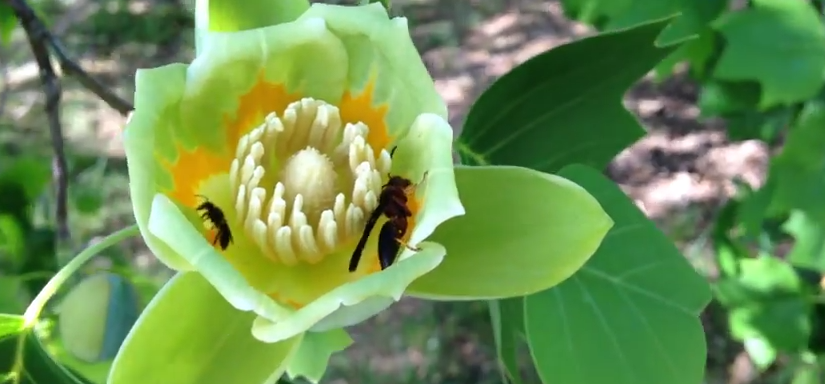I have a large tulip tree growing near my house that was there long before I bought the property. The tulip tree’s official name is Liriodendron tulipofera. It is a very nice tree to have, and I am lucky the previous owners of the property planted it.
If you like a tree that you have on your property, you do not necessarily have to plant another one. All you have to do is leave certain portions of your land unmowed and see what the wind will sow.
Okay, maybe it’s not really the wind. Sometimes the birds help, too. And even the bees must play a part in their own way. You may need bees to cross-pollinate and then birds to eat the seeds.
As soon as the blossoms open, the bees flock to the tree. At first it is very crowded, as only a few blossoms are open, so many bees must share a single flower.
But it is not only bees that are attracted to tulip tree blooms. I saw a hummingbird partaking on the first day the blossoms opened, but I was not able to get a clear picture of it. Besides common bees, there are also bumblebees.
There is much less room in the flower to accommodate a bumblebee, so there is less sharing.
But two wasps can easily share a blossom, especially if one of the wasps is smaller than the other.
There are many other insects who enjoy the tulip tree blossoms.
But as more and more blossoms open on this very tall tree, it becomes less crowded and even a very small bee can enjoy a flower all to itself.
Copyright 2015 Aya Katz

![IMG_3903[1]](https://www.pubwages.com/wp-content/uploads/2015/05/IMG_39031.jpg)
![IMG_3886[2]](https://www.pubwages.com/wp-content/uploads/2015/05/IMG_38862.jpg)

![IMG_3887[1]](https://www.pubwages.com/wp-content/uploads/2015/05/IMG_38871.jpg)

![IMG_3917[1]](https://www.pubwages.com/wp-content/uploads/2015/05/IMG_39171.jpg)


![IMG_3909[1]](https://www.pubwages.com/wp-content/uploads/2015/05/IMG_390911.jpg)
The undersides of the leaves look interesting to me.
Yes, the leaves and their undersides are really interesting. Comparing them to leaves of other trees, I see their shape is quite different and possibly unique.